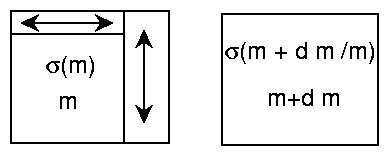Consider the process of formation of a
laminate composite. Suppose that a portion ![]() of
material
of
material ![]() is added to the composite with the effective tensor
is added to the composite with the effective tensor
![]() and that the periodic cell has volume
and that the periodic cell has volume ![]() . The material is
added in a infinitesimal thin periodic
layers with the normal
. The material is
added in a infinitesimal thin periodic
layers with the normal ![]() . The resulting composite cell has the
volume
. The resulting composite cell has the
volume ![]() and an effective properties tensor
denoted by
and an effective properties tensor
denoted by
![]() .
.
 Differential scheme
Differential scheme
Let us compute
![]() by using 8, where we
set
by using 8, where we
set
As ![]() tends to zero, we obtain
the differential equation
tends to zero, we obtain
the differential equation
This equation shows the rate of change of effective properties. It is integrated
with respect to
![]() . The functions
. The functions ![]() and
and ![]() determine the structure
of the composite. We
assume that different materials with properties
determine the structure
of the composite. We
assume that different materials with properties ![]() are added to
the composite
in different ``times''
are added to
the composite
in different ``times'' ![]() . We also assume that
. We also assume that ![]() :
The direction of laminates is generally changed during formation of the
composite.
:
The direction of laminates is generally changed during formation of the
composite.
This scheme is effectively used in our Workshop to the Workshop to compute effective properties of the Hedgehogs, Pipe-brushes, end similar structures. It is flexible and robust.